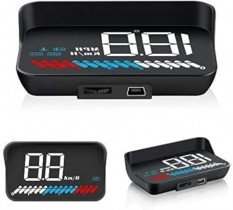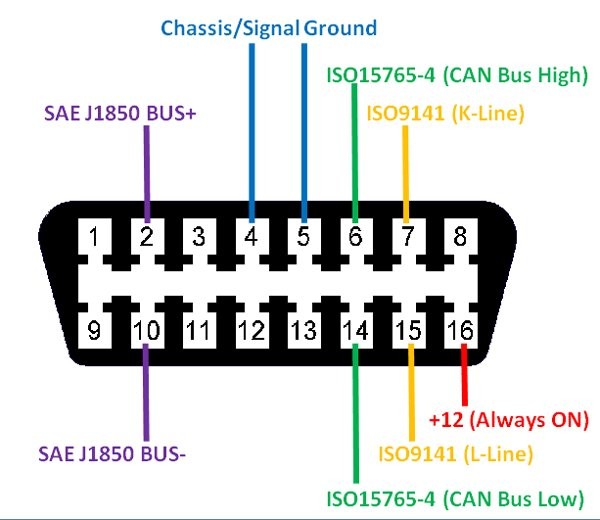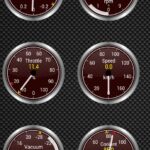Are you experiencing a flashing ABS light after installing an OBD2 speedometer in your vehicle? You’re not alone. Many car enthusiasts are drawn to the convenience and modern feel of Heads-Up Display (HUD) speedometers that plug directly into the OBD2 port. These devices project speed and other driving data onto your windshield, offering a high-tech alternative to traditional dashboards. However, sometimes integrating these gadgets can lead to unexpected issues, like a persistent ABS warning light.
 OBD2 HUD Speedometer Product Example
OBD2 HUD Speedometer Product Example
 OBD2 HUD Speedometer Display Example
OBD2 HUD Speedometer Display Example
This article provides a DIY solution to resolve ABS light activation caused by certain OBD2 speedometer models. We’ll guide you through identifying and fixing the problem, allowing you to enjoy the benefits of your new speedometer without compromising your vehicle’s safety systems.
Understanding the Problem: Why an OBD2 Speedometer Can Trigger the ABS Light
The issue often stems from a conflict within the OBD2 connector itself. Some aftermarket OBD2 speedometers, while designed to be universally compatible, may have pins that interfere with specific vehicle systems. In some cases, a particular pin on the speedometer’s connector can cause a short circuit or signal disruption, leading to the ABS (Anti-lock Braking System) light illuminating on your dashboard. This doesn’t necessarily mean there’s a fault with your ABS system itself, but rather a communication problem triggered by the newly installed device.
The Solution: Isolating and Removing the Problematic Pin
The good news is that this issue can often be resolved by identifying and carefully removing the problematic pin from the OBD2 connector of your speedometer. Through community experience, pin 11 has been frequently identified as the culprit in these scenarios. However, it’s crucial to test and confirm the specific pin causing the conflict in your situation before permanently removing it.
Step-by-Step Troubleshooting to Identify the Correct Pin
Before you start altering your speedometer’s connector, follow these steps to pinpoint the exact pin causing the ABS light issue:
- Access the OBD2 Connector: Locate the OBD2 port in your vehicle. It’s typically found under the dashboard on the driver’s side.
- Prepare Needle-Nose Pliers: You’ll need a pair of needle-nose pliers to carefully manipulate the pins on the speedometer’s OBD2 connector.
- Isolate Pins for Testing: Instead of immediately removing a pin, we’ll start by temporarily disabling them one by one. Begin by gently bending pin 9, then pin 10, and finally pin 11 towards the bottom of the connector housing using your pliers. This will prevent these pins from making contact when plugged into the OBD2 port.
- Test After Each Pin Isolation: After bending each pin (starting with pin 9), plug the OBD2 speedometer back into your car’s OBD2 port and start your vehicle. Check if the ABS light is still flashing.
- Identify the Trouble Pin: Repeat step 4 after isolating each pin (10, then 11). If the ABS light turns off after isolating a particular pin, that pin is likely the source of the conflict. In the described case, pin 11 was identified as the problematic pin.
- Remove the Confirmed Problem Pin: Once you’ve identified the trouble pin, use the needle-nose pliers to carefully remove it completely from the speedometer’s connector. Ensure you are removing the pin from the speedometer’s connector, not the OBD2 port in your vehicle.
Important Note: Do not remove any pins without testing first. Removing the wrong pin might affect the functionality of your OBD2 speedometer or other vehicle systems.
 OBD2 Connector Pinout Diagram for Speedometer Troubleshooting
OBD2 Connector Pinout Diagram for Speedometer Troubleshooting
Possible Cause: Pin Short Circuit
The underlying cause of this ABS light issue is often attributed to a short circuit or signal interference caused by one of the connector pins. By removing the problematic pin, you effectively eliminate this conflict, allowing your OBD2 speedometer to function correctly without triggering the ABS warning.
Conclusion: Enjoy Your OBD2 Speedometer Without ABS Light Issues
By following these troubleshooting steps, you can effectively identify and resolve the ABS light issue caused by your OBD2 speedometer. This simple pin modification allows you to enjoy the enhanced driving experience offered by your HUD speedometer while maintaining the integrity of your vehicle’s critical safety systems. Always exercise caution when working with vehicle electronics and consult a professional mechanic if you are unsure about any step in this process.
